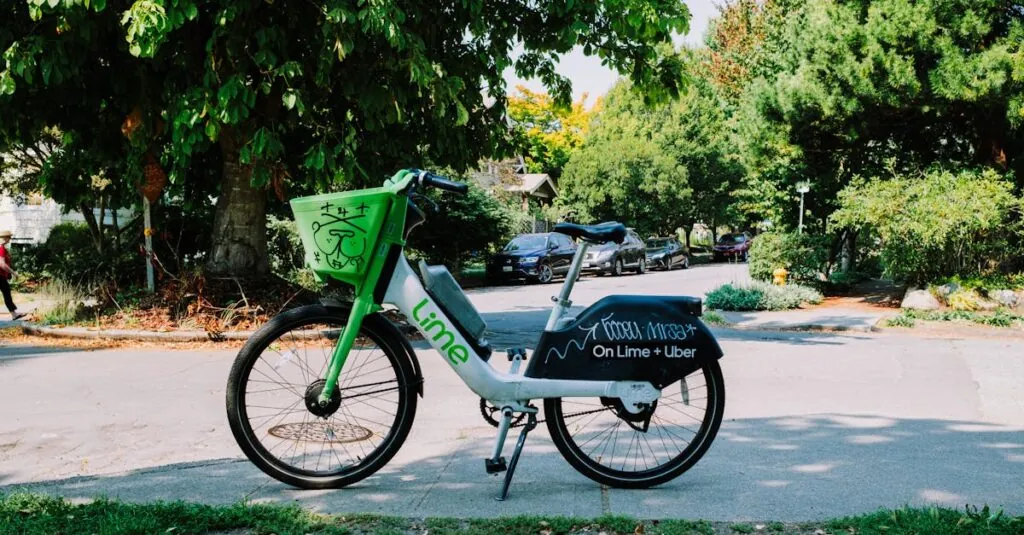Picture this: you’re zipping through the streets, wind in your hair, and a grin on your face, all while riding an electric scooter. No gas stations, no parking hassles, just pure, unadulterated fun. Electric scooter sharing has exploded onto the scene, transforming how cities tackle transportation woes. It’s like having a personal chauffeur, but way cooler and less expensive.
With a few taps on an app, anyone can hop on a scooter and glide away to their destination. It’s eco-friendly, wallet-friendly, and dare we say, the coolest way to conquer urban jungles. Whether you’re late for work or just want to impress your friends, electric scooter sharing is the answer. So, why not join the revolution and discover the joy of effortless travel?
Table of Contents
ToggleOverview Of Electric Scooter Sharing
Electric scooter sharing has emerged as a significant player in urban transportation. Its growth reflects a shift towards convenient and sustainable travel options.
History And Development
Electric scooter sharing originated in the early 2010s when companies began introducing micro-mobility solutions. The first notable service launched in 2017 in Santa Monica, California, soon leading to rapid expansion across major cities worldwide. Regulatory challenges prompted adjustments in business models, making the scooters safer and more accessible. In 2018, several companies entered the market, vastly increasing competition. Popularity surged as urban residents sought eco-friendly alternatives to car travel, promoting the growth of scooter-sharing programs across continents.
Current Trends In The Market
Market dynamics show significant growth in electric scooter sharing, with usage expected to rise by 25% annually through 2025. Many urban areas embrace this mobility option to alleviate congestion. Riders prefer electric scooters not only for their convenience but also for their affordability compared to traditional transportation methods. Companies are investing in fleet expansion and technological advancements, enhancing user experience with improved battery life and app functionality. Partnerships with local governments are increasingly common, ensuring smoother integration of scooters into urban transportation networks.
Benefits Of Electric Scooter Sharing
Electric scooter sharing offers numerous advantages that cater to today’s urban lifestyle.
Environmental Impact
Electric scooters significantly reduce carbon footprints. They operate on clean energy, producing no tailpipe emissions. Using scooters instead of cars lowers overall traffic congestion and air pollutants. Studies show that replacing short car trips with electric scooter rides can decrease greenhouse gas emissions by up to 30%. Urban areas benefit from reduced noise pollution as well, creating a more peaceful environment. Moreover, electric scooters contribute to better urban mobility, encouraging more people to opt for eco-friendly transport solutions.
Economic Advantages
Economic benefits come with the rising popularity of electric scooter sharing. Users save money compared to owning a car or taking public transport. Average ride costs range from $1 to $4, making it an affordable alternative for short trips. Cities also experience financial relief through decreased parking demand and maintenance costs for road infrastructure. Companies investing in electric scooters are boosting local economies by creating jobs in fleet management and maintenance services. Additionally, partnerships with local governments often lead to grants and subsidies that enhance the overall sustainability of the urban transport system.
Challenges Faced By Electric Scooter Sharing
Electric scooter sharing encounters various challenges that can impact its widespread adoption and effectiveness. Key issues include safety concerns and regulatory obstacles.
Safety Concerns
Safety concerns pose significant challenges for electric scooter sharing. Riders often lack experience, leading to accidents when navigating urban environments. Studies show that cities with higher scooter usage experience increased injury rates. Additionally, inadequate infrastructure contributes to hazards, as many roads lack designated lanes for scooters. Pedestrian safety becomes compromised when scooters are parked improperly, creating obstacles on sidewalks. To address these issues, companies implement safety measures like user safety education and improved helmet availability.
Regulation Issues
Regulation issues hinder the growth of electric scooter sharing. Many cities struggle to develop comprehensive policies that balance user access with public safety. Permit processes can be lengthy, causing delays and limiting the number of scooters available for users. Local governments often impose strict operating conditions, including speed limits and parking requirements, which may vary significantly from one area to another. Companies face difficulties in compliance due to these inconsistent regulations, which complicates expansion efforts. Collaboration with local authorities is essential for establishing effective and uniform regulatory frameworks.
Popular Electric Scooter Sharing Programs
Numerous electric scooter sharing programs have gained traction, emphasizing convenience and accessibility for urban dwellers. These programs vary in scope, structure, and service quality.
Case Study: Program A
Program A operates in over 30 cities, providing over 50,000 scooters. It prioritizes safety through mandatory helmet features and user training sessions. Riders can locate scooters via a user-friendly app, which offers real-time availability updates. Monthly subscriptions attract frequent users, generating significant revenue streams. Partnerships with local governments enhance operational efficiency and ensure compliance with regulations. City-specific features, such as designated parking areas, improve integration into urban transport systems. This program reported a 40% increase in ridership in 2022, further solidifying its presence in the market.
Case Study: Program B
Program B features a fleet of 25,000 scooters across 20 locations. This service focuses on eco-friendliness, utilizing electric scooters with lower carbon impacts. The app allows users to book rides and access promotional discounts to encourage usage. Monthly user feedback surveys help in adapting services to meet customer needs. Through collaborations with local businesses, Program B offers discounts for riders who frequent supporting shops, boosting both ridership and local commerce. A significant 35% of users transitioned from short car trips to scooters, showcasing a positive shift toward sustainable transport options.
Future Of Electric Scooter Sharing
Electric scooter sharing is set to evolve with advancements in technology and expanding market opportunities.
Technological Innovations
Innovations in technology play a crucial role in the future of electric scooter sharing. Companies are integrating smart features, such as GPS tracking and real-time availability updates, enhancing user convenience. Mobile apps now offer seamless payment options, allowing users to rent scooters with a few taps. Data analytics is being utilized for optimizing fleet management, ensuring scooters are placed where demand is highest. Electric scooters also benefit from battery advancements, increasing range and reducing downtime for charging. Enhanced safety features, like collision detection and integrated lights, promote safer riding experiences and attract more users.
Potential Market Growth
Market growth in electric scooter sharing shows promising trends. Projections indicate a 25% annual increase in usage through 2025, as urban populations seek efficient transportation alternatives. Cities are actively adopting electric scooters to combat congestion and reduce carbon emissions. Partnerships with local governments are increasing, facilitating smoother integration into existing transportation networks. Investment in infrastructure, such as dedicated scooter lanes and charging stations, supports enhanced accessibility. Research suggests that over 50% of users switch from short car trips to scooters, indicating a substantial shift toward this eco-friendly option. The combination of these factors positions electric scooter sharing for exponential growth.
Conclusion
Electric scooter sharing is reshaping urban mobility and offering a fresh perspective on transportation. As cities embrace this eco-friendly alternative, the convenience and cost-effectiveness of electric scooters become increasingly appealing.
With technological advancements and strategic partnerships, the future looks bright for this innovative mode of transport. Safety measures and regulatory frameworks will play a crucial role in ensuring sustainable growth.
As more individuals opt for electric scooters over traditional vehicles, the positive impact on the environment and local economies will continue to grow. Urban dwellers are encouraged to explore the benefits of electric scooter sharing and join the movement towards smarter, greener cities.




